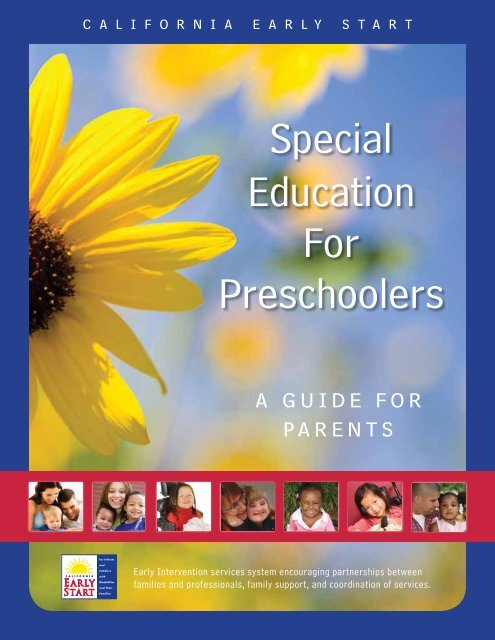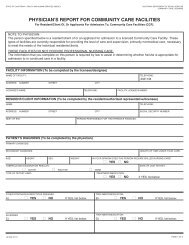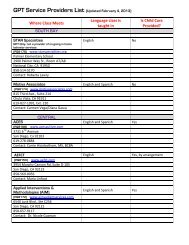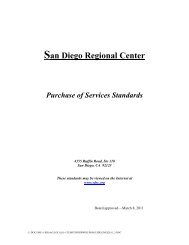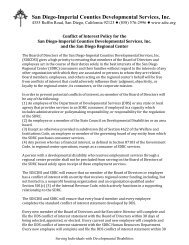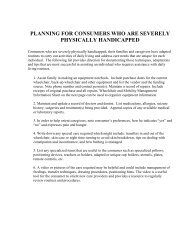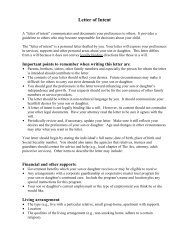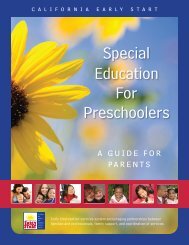Special Education For Preschoolers - San Diego Regional Center
Special Education For Preschoolers - San Diego Regional Center
Special Education For Preschoolers - San Diego Regional Center
Create successful ePaper yourself
Turn your PDF publications into a flip-book with our unique Google optimized e-Paper software.
Table of ContentsContacts..............................…………………………………………………….…………1Timelines...........................................................................................................................2Introduction (Dear Parents)…………………………………………………….…………3What is <strong>Special</strong> <strong>Education</strong>?................................................................................................4What Does IDEA Provide?.................................................................................................4Differences Between Infant/Toddler and Preschool Programs.............................................5Assessment Procedures......................................................................................................6Determining Eligibility for <strong>Special</strong> <strong>Education</strong> ...................................................................7What is the Purpose of an IEP?..........................................................................................8Parent Involvement in <strong>Education</strong> Decisions.......................................................................9The Individualized <strong>Education</strong> Plan (IEP)...........................................................................9What Are the Components of an IEP? ............................................................................10Least Restrictive Environment (LRE)...............................................................................11<strong>Education</strong>al Settings........................................................................................................11Community Settings.....................................……………………………………....…….12<strong>Special</strong> <strong>Education</strong> Preschool............................................................................................13Parent Rights and Procedural Safeguards.....……………………………..……....…....…14You Have Responsibilities, Too....................……………………………..……....…....…14Acknowledgements……………...................................…………………………..……..15
E A R L Y S T A R T T R A N S I T I O N2Transition Year TimelinesChild turns 2 years old••A goal is written on the Individualized Family Service Plan (IFSP)that transition planning activities will occur••“Early Start Transition for Parents” booklet is offered to family••Permission to share child information with district is signedAround 2 years six months••IFSP periodic review••“<strong>Special</strong> <strong>Education</strong> Services for <strong>Preschoolers</strong>” booklet offered to family••Service coordinator schedules IFSP for transition conference meetingAround 2 years nine months (or as early as 2 ½ )••Transition Planning Meeting with representatives from school districts,Head Start, etc. to explain their services to familyBy 2 years 10 months••Family receives an Assessment Plan from district Family signs andreturns Assessment Plan beginning 60 day timelineBefore Third birthday••IEP meeting is held and if child is eligible IEP is writtenThird birthday••Child begins services*Children referred between 2 years 10 months and 3 years old are offered booklets at first meeting
3E A R L Y S T A R T T R A N S I T I O NDear Parents,This booklet is all about special education and what you need to know tomake it a positive experience for your child. You will want to understand theprocesses and procedures that will occur, as well as your rights as a parent,in order to make decisions and actively participate in the meetings. Theremay be a number of new terms that you are not familiar with, but continuereading and the term will be explained in more detail.During the last six months that your child is in Early Start, a specific timelineof procedures is required. There will be decisions you want to participate inthat may lead up to a referral to special education and culminate in developingan Individualized <strong>Education</strong> Plan (IEP) for your child. Your partnershipwith the professionals during this process is critical. As you are an importantmember of the team and know your child best, be sure to ask any questionsyou have and provide any information you feel is pertinent.Moving from the Early Start program may be unsettling. Many things arechanging at once. You will be learning new terms and beginning relationshipswith new people. Help your child to begin his/her new experience by stayingpositive and taking care of yourself. It may help to remember that thedecisions you make now do not have to be permanent. It’s okay to makeplans and change them later if you need to.In additional to reading this booklet, you may want to talk with someone whois familiar with the special education system. You can ask your service provideror staff at the school district for more information. You may also call theExceptional Family Resource <strong>Center</strong> (EFRC) to speak to a parent who has beenthrough the process with their own child. We all want your child to progressin the upcoming years and to support you through the educational process.Your District’s <strong>Special</strong> <strong>Education</strong> Staff and EFRC
E A R L Y S T A R T T R A N S I T I O N 22 4What is <strong>Special</strong> <strong>Education</strong>?<strong>Special</strong> education, part of the public education system, is instruction and related servicesdesigned, at no cost to you, to meet your child’s unique educational needs, which cannotbe met through modification of the general education curriculum. It provides a continuumof service options to meet the educational needs of children with disabilities in theleast restrictive environment. <strong>Special</strong> education provides your child specially designedinstruction to enable him/her to progress. Your rights and protection for these servicesare guaranteed under the Individuals with Disabilities <strong>Education</strong> Act. (2004),a federal law referred to as IDEA.What Does IDEA Provide?The six primary components of IDEA are:1. Assessment/Evaluation ProceduresAssessment/evaluation is the first step in determining if your child is eligible forspecial education. No assessment may be conducted without your writtenconsent on the Assessment Plan.2. Parent Involvement in <strong>Education</strong>al DecisionsThe law provides for your involvement in the assessment process and at the IEPmeeting. You are an essential part of the IEP team. It is important to askquestions and share your perspective at all times.3. Placement in the “Least Restrictive Environment” (LRE)IDEA requires that your child be educated in the LRE, that environment whichis as close as possible to general education with children who are not disabled.LRE is determined by the IEP team, and may or may not be in a generaleducation classroom setting.4. A Free and Appropriate Public <strong>Education</strong> (FAPE)IDEA ensures your child with special needs, between the ages of 0-22 years,receives an educational program specially designed to meet his or her uniqueneeds, provided at no cost to you.5. A Written Individualized <strong>Education</strong> Program (IEP)Before your child receives special education services, a written IEP is developed.It is reviewed at least annually at a meeting in which you attend and participate.<strong>Special</strong> education services begin only after you agree to and sign the IEP.6. The Right of Due Process, if there is a DisputeThis is a safeguard that protects your rights as a parent or guardian to disagreewith educational decisions made for your child.
5E A R L Y S T A R T T R A N S I T I O NDifferences Between Infant/Toddlerand Preschool ProgramsEarly Start infant/toddler programs are based on a model where services aredelivered in natural environments such as community settings or at home.Infants and their families receive early intervention services individuallyor in small groups. Emphasis is placed on providing support to the parentand child through the help of a “service coordinator”. The focus of EarlyStart is on the child and family, while the goal is to assist parents insupporting the growth and development of their child with special needs.When your child begins a preschool program, the emphasis shifts to aneducational model which focuses solely on your child. The emphasis ofthe preschool program will be on meeting your child’s unique needs.The preschool curriculum is based on the California Preschool Standardswhich focus on social interaction with children and adults, languagedevelopment, and other pre-academic skills. Teaching activities inpreschool generally occur in a large group, small groups, and/or atlearning centers. Your child may receive some individual instructionand/or service to address goals developed in the IEP.Length of Day and Number of Days Per Week:The schedule for your child’s preschool program will probably be quitedifferent from the infant program. Generally, preschool programs meettwo to five half-days per week. The amount of time your child spendsin preschool is dependent on his/her needs and is not the samefor all children.Location of the Program:Sites for special education preschool programs may vary. Your child willbe provided opportunities to participate in a variety of activities withchildren without disabilities to the extent that is appropriate.
E A R L Y S T A R T T R A N S I T I O N 6Assessment ProceduresThe goal of the school district’s assessment team is to obtain information about your child.This information is used to determine if your child is eligible for special education and toidentify his/her areas of need. An assessment (sometimes referred to as an evaluation) is away of looking at the whole child to learn about his or her strengths and areas of need.You are an important member of the team, and you can provide valuable information aboutyour child. Remember, your child will be assessed only in the areas of concern. You may wantto share with staff assessment or developmental assessments completed by other agencies.No testing will occur until you have been notified of the types of assessments to be done andyou give your written consent for the assessment. A Case Manager from the school districtwill send you paperwork requesting you to give written consent for district staff to assess yourchild. The assessment plan (or evaluation plan) identifies the areas of need to be assessed suchas communication, academic, motor, health, etc, and the specialist who will administer them.If you feel an area of need has not been addressed, be sure to contact the case manager todiscuss your concerns. You will also be given a copy of Parent Rights and Procedural Safeguardsthat describe your rights in the assessment and education of your child.Assessments typically include the following:••Observations by staff who have worked with your child.••Medical history, when it’s relevant to your child’s performance in school.••Information you provide about your child’s previous school experiences, abilities,behavior outside of the school setting, and feelings about school.••When standardized tests are considered inappropriate for children ages three throughfive years, alternative procedures may be used, such as developmental checklists,observations and interviews.••A variety of assessment procedures may be used to assess your child: Your child maybe seen individually with different members of the assessment team, or you and yourchild may be involved with all of the team members during one appointment.Remember, you’ve known your child longer than anyone, and you observe him/her inmany different situations. You have important information to offer!
7E A R L Y S T A R T T R A N S I T I O NThe assessment forms the basis for your child’s educational plan. <strong>For</strong> that reason,it is important that you, as the parent, participate to ensure that an accurate pictureof your child is obtained. All tests are administered by qualified personnel, and avariety of assessments procedures will be used. Tests are an important part ofthe assessment process and are comprehensive. Your child will be assessed inhis/her primary language, or other mode of communication, in a way thatdoesn’t discriminate in terms of disability or racial/cultural background.If you agree with the Assessment Plan, as soon as possible sign, date and returnit to the school district staff member who prepared and sent the materials. Theassessment cannot proceed until it is received. Once the District receives yoursigned Assessment Plan, District staff will schedule the assessment. An IEPmeeting must be held within 60 calendar days of receipt of your writtenconsent (not counting school recess days in excess of 5 school days).Determining Eligibility for <strong>Special</strong> <strong>Education</strong>Eligibility for special education services at age 3 years is determined by theIEP team based on the results of the assessment of your child. Your childis eligible if, based upon assessment results, he/she meets the California<strong>Education</strong> Code eligibility criteria for one of the following 13 disabilities:••Autism••Deaf••Deaf-blind••Emotional disturbance••Hearing impairment••Mental retardation••Multiple disabilities••Orthopedic impairment••Other health impairment••Specific learning disability••Speech or language impairment••Traumatic brain injury••Visual impairment
E A R L Y S T A R T T R A N S I T I O N 8What is the Purpose of an IEP?Once a child has been referred and an assessment completed, an IEP meeting is held. TheIEP meeting has several purposes. The team shares the assessment information to determineif your child meets eligibility criteria specified by the state to be considered a child with adisability. If a child is eligible for special education, the second purpose is to developmeasurable annual goals in the areas of your child’s identified needs. The third purpose of anIEP meeting is to ensure that appropriate special education services are identified to addressyour child’s needs. At the conclusion of the IEP meeting, you may request to observe theproposed educational program. If your child is eligible to receive services through the schooldistrict, you will need to register/enroll your child at the school.What is the Team Approach?The team approach is the cooperative effort between you and the various specialists todevelop the IEP that meets your child’s needs. You are an important part of the team. At theIEP meeting, the IEP team reviews assessment results, determines eligibility, and develops theIEP. The meeting is held at the school at a time that is mutually agreeable to parents and staff.Teachers and other specialists keep records of your child’s service and progress. You will beinformed of your child’s progress three to four times a year.Who Participates in an IEP Meeting?It is required that the following individuals participate at an IEP meeting:••You, the parent or guardian••A district designee••A special education provider (such as a special education teacher,speech pathologist, etc.).••A general education teacher••The staff who have assessed your child, or someone who understandsthe assessment procedures used with your child and is familiar with the results••Other members may include those determined by the school (e.g., interpreter,psychologist, counselor)••Other individuals you invite to the meeting who have knowledge of yourchild (e.g., friend of parents, or a <strong>Regional</strong> <strong>Center</strong> representative if yourchild is a <strong>Regional</strong> <strong>Center</strong> client)
E A R L Y S T A R T T R A N S I T I O N 10What Are the Components of an IEP?1. Your Child’s Present Level of PerformanceThese are statements describing your child’s strengths and areas of need based onassessment results. These statements describe your child skills and likely matchyour knowledge of your child’s abilities.2. Annual Long Term GoalsGoals are developed based on the assessment information to address your child’s areasof need. They focus on skills and behaviors that your child and his/her teacher willtarget over the next school year (e.g. , Mary will match the basic colors; Bobby willuse 2 word phrases to communicate his wants and needs). Your input will helpdetermine if these goals are appropriate based on what you know about your child.3. <strong>Education</strong>al ServicesThe IEP team determines the programs and/or services your child needs to benefit fromhis/her educational program. A statement of the extent to which your child will beincluded in the general education program is also in the IEP. Some meaningful contactwith “typical” children the same age should be defined.4. Related ServicesRelated services will be provided to a child who is found eligible for special education ifthey are identified by the school district’s IEP team to be educationally necessary for thechild to benefit from his special education program. Related services include: adaptedphysical education (APE), audiological services, speech/language therapy, occupationaltherapy, orientation and mobility services, assistive technology, etc. Instruction maybe provided at a local school or other community/education setting. The IEP willindicate the date the service begins, and how long it will last, the location, and howfrequently it will be provided.5. Evaluation and ReviewThe teacher(s) and other specialists who work with your child are responsible fordesigning learning tasks and activities to help your child achieve the goals. Althoughthe goals are written, the IEP does not guarantee that the child will develop those skills.The IEP needs to be reviewed at an IEP team meeting at least once per year. At theannual meeting, you will receive information from your child’s teacher and orspecialists about the progress your child has made. Sometimes, samples of yourchild’s work will be brought to the meeting to share with you. You may request anIEP meeting before a year, and one will be held within 30 days of your request.
11E A R L Y S T A R T T R A N S I T I O NLeast Restrictive Environment (LRE)The federal and state laws that govern special education require that the IEPteam provide programs and services in the Least Restrictive Environment(LRE). Least Restrictive Environment is defined as the setting that ensuresyour child is educated with typically developing children to the maximumextent appropriate. The concepts of “mainstreaming” and “inclusion” arebased on Least Restrictive Environment.<strong>Education</strong>al SettingsIDEA gives you the opportunity to decide, with the members of the IEPteam, the least restrictive educational setting that will meet your child’seducational needs. Options may include:••<strong>Special</strong> instruction provided by a specialist in a public generaleducation preschool classroom.••Related Service only: The setting for your child’s service may notalways be a classroom. <strong>For</strong> example, if your child only receivesspeech therapy, the service may be provided at a local public schoolat scheduled dates and times.••Preschool <strong>Special</strong> <strong>Education</strong> classrooms: a setting for childrenwith significant disabilities who need the majority of their specialeducation service provided in a self-contained classroom.These classrooms are typically located at schools in the district.
E A R L Y S T A R T T R A N S I T I O N 12Community Public Preschool OptionsWithin the community, there are a variety of public preschool options:Parent Participation Preschool Classes operated by the adult educational programare provided at some community colleges. These preschool classes allow parents orcaregivers to participate with their child in a developmentally appropriate preschoolprogram. A variety of class schedules are offered throughout the week. Parentparticipation in the program decreases as children get older so that the preschoolershave increasing experience in larger groups. Parents are able to learn skills for workingwith their child as well as get support from other parents in the program.Head Start is a federally funded preschool program that primarily serves children fromfamilies who meet income eligibility. Head Start is required to make available at least 10percent of all its funded slots to children with special needs. Some Head Starts providetransportation. Due to space limitations, Head Start gives priority to 4-year old childrenwho meet income guidelines and to children who have special needs. There is no cost toparents for this program; however, parents are strongly encouraged to volunteer time inthe classroom or on various advisory committees. It is helpful to invite a Head Startspecial education coordinator to your child’s transition IFSP meeting. If interested, haveyour Service Coordinator contact HS and arrange for their participation in the IEP.Child Development <strong>Center</strong>s are state- and federally-funded preschool programsprovided by public, private and parochial agencies. These programs primarily serveparents who require childcare because they are working or in training for work. Eligibilityis based upon the family income. A fee may be charged depending upon the family’sincome level. <strong>Center</strong>s are generally open at 6:30 a.m. and closed between 5:30 and6:00 p.m. Children who are 2 ½ through preschool age are eligible. The facility must belicensed by the state department of social services community care licensing division.State Preschool Programs are operated in some local school districts. These programsare half-day preschool programs that provide developmentally appropriate instructionfor children. Some state funded preschool programs have income requirements forfamilies. Parent involvement is encouraged. More information about state funded andother district preschool programs is available from your local school district.
E A R L Y S T A R T T R A N S I T I O N 14Parent Rights and Procedural SafeguardsAt the beginning of the assessment process, the District provides you with a copy of theParents’ Rights and Procedural Safeguards. It is important for you to read and review them asthey inform you of the process (from evaluation through IEP implementation) and the rightsof your child as a special education student.The following is a very brief summary of your rights, although you will want to read them intheir entirety. You have the right to:••Participate in the assessment and development of the IEP••Be informed of continuum of program options••Receive prior written notice when the district requests to initiate a change in the IEP••Decide if your child will be assessed or receive special education (you mayrefuse to consent)••Inspect, review and/or obtain copies of your child’s school record••Exercise due process, and, in such situations, are encouraged to participatein a resolution and mediation sessionYou Have Responsibilities, Too…It is important for you to understand basic information about your rights and protections underspecial education law. It is also important for you to understand you also have responsibilities.You have the responsibility to:❑❑Ask questions when you do not understand terms or reports❑❑Become and remain an active member of the team❑❑Share your perspective with accurate information about your child❑❑Make suggestions about your child’s educational setting and services❑❑Help your child grow and develop<strong>For</strong> more about parent rights and procedural safeguards, contact:Name: _________________________________________________________Title: __________________________________________________________Agency: ________________________________________________________Phone: _________________________________________________________Phone: _________________________________________________________Other: _________________________________________________________
15E A R L Y S T A R T T R A N S I T I O NAcknowledgementsThe <strong>San</strong> <strong>Diego</strong> Early Start Guides for Parents on Early Start Transitionand Preschool <strong>Special</strong> <strong>Education</strong> were developed by members of the<strong>San</strong> <strong>Diego</strong> Countywide Early Start Transition Committee with inputfrom the <strong>San</strong> <strong>Diego</strong> County Early Start Administrators Team andrepresentatives from the Exceptional Family Resource <strong>Center</strong> (EFRC),<strong>San</strong> <strong>Diego</strong> <strong>Regional</strong> <strong>Center</strong>, and personnel from local school districts.We want to acknowledge the hours of effort on behalf of these memberstoward making this guide useful, meaningful, and accurate.A special thank you to our colleagues in the Los Angeles County Officeof <strong>Education</strong> whose Early Start Transition: a Guide for Parents series wasused as a reference model for format and content.We also wish to thank HOPE Infant Family Support Program forallocating funding to design and develop these guides and theExceptional Family Resource <strong>Center</strong> for facilitating the processfrom design to dissemination.SAN DIEGOREGIONAL CENTER
Notes:
Transition/Preschool Guide 8/2010Exceptional Family Resource <strong>Center</strong>9245 Sky Park Court Ste 130<strong>San</strong> <strong>Diego</strong>, California 92123(800) 281-8252


